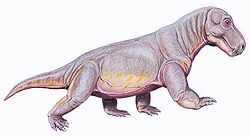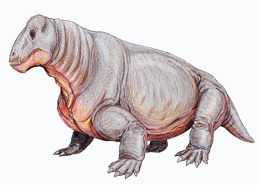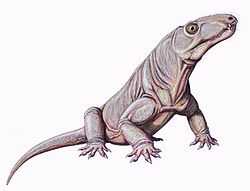Jonkeria
| Jonkeria Temporal range: Capitanian, 265–260Ma | |
|---|---|
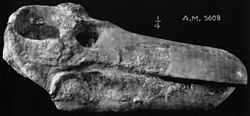 | |
| Jonkeria ingens skull, Amer. Mus. No. 5608 | |
| Scientific classification | |
| Kingdom: | Animalia |
| Phylum: | Chordata |
| Clade: | Synapsida |
| Order: | Therapsida |
| Suborder: | †Dinocephalia |
| Family: | †Titanosuchidae |
| Genus: | †Jonkeria |
| Species | |
| |
| Synonyms | |
| |
Jonkeria was a very large omnivorous (although there is some dispute to this - e.g. Colbert 1969 p. 136) dinocephalian, from the Tapinocephalus Assemblage Zone, Lower Beaufort Group, of the South African Karroo.
Description

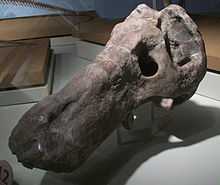
The overall length was 3.5 metres (11 ft) or more (up to 4 or 5 metres (13 or 16 ft)), the skull about 55 cm long. The skull is nearly twice as long as wide, and the snout is elongated and provided with sharp incisors and large canines. The cheek teeth were rather small.The body is robustly built, and the limbs stout. According to Boonstra 1969 p. 38, Jonkeria cannot be distinguished from its relative Titanosuchus on cranial grounds, but only in limb length; Jonkeria having short and squat limbs, and Titanosuchus long ones.
Classification

About a dozen species have been named, including the type species, J. truculenta. At least some of the other species were synonymised by Boonstra 1969. There has been no recent review of the genus.
See also
References
- Boonstra, L. D. 1969, "The Fauna of the Tapincephalus Zone (Beaufort Beds of the Karoo)," Ann. S. Afr. Mus. 56 (1) 1-73, pp. 35-38
- Colbert, E. H., (1969), Evolution of the Vertebrates, John Wiley & Sons Inc (2nd ed.)
- von Zittel, K.A (1932), Textbook of Paleontology, C.R. Eastman (transl. and ed), 2nd edition, Macmillan & Co. vol.2, p. 255
| ||||||||||||||||||||||||||||||||||||||||||||||||||||||||||||||||||||||||||||||||||||||||||||||||||||||||||||||||||||||||||
